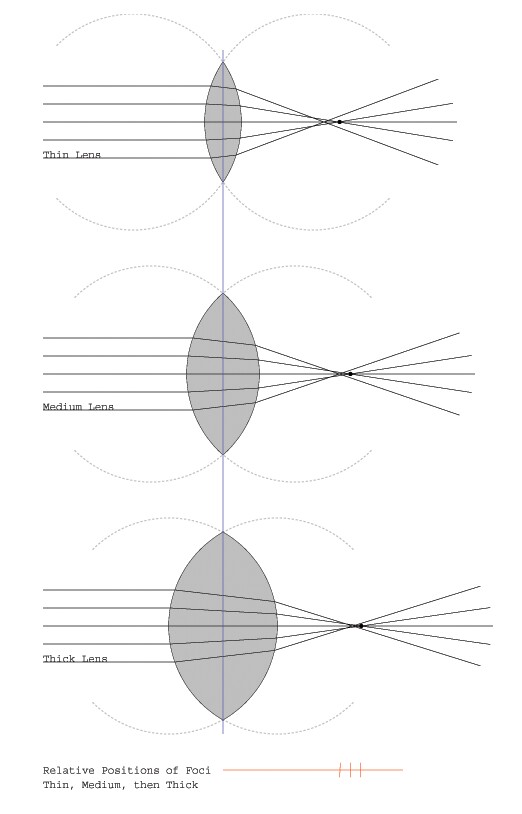The first lens shown here is very thin, and has a focus that is relative close to the lens. In the image, there are also two shaded/dashed gray circles. These circles represent the two intersecting spheres that were used to from these particular lenses. As you look through the various lenses, notice that the two grey circles move closer and closer together. There is also a light blue line that runs through the center of each of the lenses. This line represents the seconday axis of the lens. It also does not change in each of the lens cases.
One thing that you may notice in the thin lens is that the rays that hit the extremities of the lens do not seem to focus where all the other rays do. Based on this model, it turns out the rays toward the edges do show this behaviour. We can also notice this "imperfection" in the design of our own eyes. Even though eyes are supposed to be spherically symmetrical about a central axis, we do not see images that are off-center as clearly. This forms our peripheral vision, which is in general quite blurry. This is based partially based on this "imperfect" focusing of our own eyes, and the fact that our receptors on our retina tend to be focused near the center of our retina, at the fovea.
In the medium lens, you will notice that the focus seems to have moved out a bit. Also, the rays from the extremities seem to focusing closer to the original focal point, at least versus the thin lens case. In each of the pictures, the lens thickness doubles.
In the thick lens, the lines almost focus together at the same point, and the focal point has been further still. This "thick" lens best approximates the lens of our eye at rest. When the eye is focusing on distance objects, it relaxes the ciliary muscles controlling our lens, and allows it to take this resting thickness. As we focus on closer objects, these reduced thickness of the lens causes the focal length to shorten, which brings the items into focus.
On the bottom, there is a line with the relative focal distances for each of the three lens thicknesses. When you consider that the human lens is only a fraction of the lens shown at the right, the actual variations in focal lengths is considerably smaller. Despite this, our eyes allow us to focus and see objects from 30 cm to kilometers away with only a small adjustment.
It turns out that there is another factor that allows the lens to focus properly. Since it is inefficient to have out eyes expand or contract everytime, there is another factor in play.
